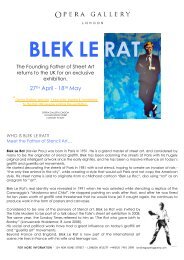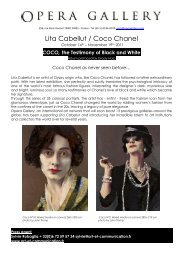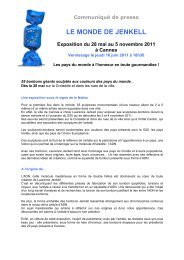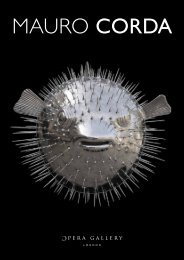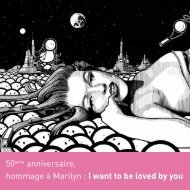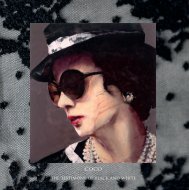Download - Opera Gallery
Download - Opera Gallery
Download - Opera Gallery
You also want an ePaper? Increase the reach of your titles
YUMPU automatically turns print PDFs into web optimized ePapers that Google loves.
With respect to dots, Kusama declared on<br />
Kusama was often invited to appear on<br />
numerous occasions:<br />
Japanese television. Such moments promoted<br />
her fame, while leaving impressions<br />
“My life is a Dot lost among thousands<br />
Her encounter with the American sculptor<br />
that would play an important role in her future<br />
It is precisely this rebirth period, from 1981<br />
of other dots.”<br />
and experimental filmmaker Joseph Cornell<br />
literary works.<br />
to the present, which is highlighted in the<br />
would strongly influence her creative pro-<br />
exhibition organized by <strong>Opera</strong> <strong>Gallery</strong>,<br />
Kusama Yayoi is definitely one of the<br />
cess. Cornell’s fantastic imagination can be<br />
The 70s were, however, a dark period<br />
Hong Kong.<br />
world’s most distinctive and influential mul-<br />
Her European travels and exhibitions<br />
characterized by the assembly of lost and<br />
in Kusama’s creative life. Following the<br />
In that same year, both the Tokyo and Kyoto<br />
tidisciplinary conceptual artists. After 70<br />
inspired the artist’s “Accumulation” series:<br />
found objects, making him a pioneer in this<br />
death of her partner Joseph Cornell, and<br />
Modern Art Museums included Kusama in<br />
years of active practice, her works continue<br />
with touches of absurdity and exuberance<br />
type of artistic expression. André Breton<br />
shortly thereafter of her own father,<br />
a list of the most important painters of the<br />
to amaze us, with such an incredible feeling<br />
covering ordinary objects and furniture with<br />
would say: “he enjoys an experience that<br />
Kusama’s health (psychic but also physical),<br />
1960s, with her works highlighted in an<br />
of creative power radiating from her works.<br />
phallic protuberances. This series was ac-<br />
upsets the conventions of how we use<br />
started to deteriorate. She created new<br />
exhibition called The 1960s: A Decade of<br />
claimed by famous artists like Oldenburg,<br />
objects”. Their relationship illuminated and<br />
collages (“Message of Death from Hades”)<br />
Change in Contemporary Japanese Art.<br />
Started in 2011, and scheduled to continue<br />
Morris, Warhol, Lichtenstein, Wesselmann,<br />
enriched Kusama’s private life, and conti-<br />
which were exhibited in Tokyo’s Nishimura<br />
It was, in fact, this total reappraisal of Kusama<br />
throughout 2012, Yayoi Kusama’s solo<br />
or feminist culture critic Lucy Lippard (who<br />
nued until Cornell’s death in 1973.<br />
<strong>Gallery</strong>. This eccentric exhibition, so em-<br />
as an artist, by her own country and by the<br />
exhibition has been hosted by the most<br />
proclaimed Kusama as the precursor of<br />
otionally striking, grabbed the attention of<br />
international art world, that gave a new im-<br />
preeminent contemporary art museums<br />
Eccentric Abstraction).<br />
From 1965, Kusama shared a studio with<br />
art critic Akira Tatehata, who would play an<br />
pulse to her creativity.<br />
worldwide - in Madrid, Paris, London and<br />
well-known Japanese artist On Kawara, who<br />
important role in Kusama’s future.<br />
New York.<br />
would become one of the most important<br />
From 1981, numerous and remarkable<br />
conceptual artists in Asia. In the same year,<br />
After a few short stays in Tokyo, and, more<br />
retrospectives would contribute to her<br />
In response to Frances Morris, the curator<br />
Kusama produced her famous “Infinity<br />
importantly, after a suicide attempt, exhaus-<br />
international reputation, culminating with<br />
of Tate Modern show in London, Kusama said:<br />
Mirror Room - Phalli’s Field” (or “Floor Show”).<br />
ted, Kusama decided to return to Japan for<br />
the famous solo exhibition Kusamatrix, or-<br />
Towards the end of the 60s, Kusama began<br />
good. As of 1977, she became a permanent<br />
resident of a psychiatric clinic in Tokyo. Un-<br />
ganized by the Mori Art Museum, Tokyo in<br />
2004. The exhibit attracted more than half a<br />
Dots 1999, acrylic on canvas, 33,3 x 24,2 cm<br />
“I have a flood of ideas in my mind…<br />
I just follow my vision”.<br />
her first “happenings’’ (public theater):<br />
der such depressing conditions, she edited<br />
million visitors.<br />
The show combines a variety of works from<br />
poems and an art album (“7”). As of this<br />
Kusama’s eclectic and rich pallet, including<br />
Galina COULOT<br />
“Obliterate your personality with polka<br />
sadly remarkable year, her artistic creativity<br />
In 1993, Kusama was selected to represent<br />
the famous pumpkins, infinity nets and dots<br />
Art Historian critic<br />
dots<br />
declined and she remained in the shadows<br />
Japan at the Venice Biennial. She chose one<br />
paintings.<br />
Become one with eternity<br />
until 1981.<br />
of her main subjects, pumpkins, to create<br />
Become part of your environment…<br />
the installation “Mirror Room - Pumpkins”.<br />
Kusama’s obsession with dots from such<br />
Flames 1990, acrylic on canvas, 53 x 45,5 cm<br />
Take off your clothes<br />
Forget yourself<br />
This magnificent and unforgettable work<br />
again depicted the red line of her plastic<br />
a young age is probably related to the hallucinations<br />
she suffered as a child. These<br />
Make love<br />
creation, a concept comprised of accumu-<br />
famous dots of various forms, shapes and<br />
Self-distraction is the only way to peace.”<br />
lation, repetition and infinity.<br />
colours would become her trademark; for<br />
the first time in 1965, she proposed polka<br />
These slogans perfectly illustrate Kusama’s<br />
dots combined with mirrors (Phalli’s Field).<br />
artistic spirit of the period.<br />
Dots became an integral part of her “hap-<br />
06<br />
penings” or experimental movies, as an expression<br />
of her opposition to the Vietnam<br />
War. She used the visual capacity of the<br />
07<br />
dots to “break” an object by destroying the<br />
details of shape or silhouette.



